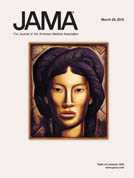PLoS Med:身材高挑的女性更容易患卵巢癌
2012-04-10 生物探索 生物探索
4月3日,来自国际著名杂志PLoS Medicine上的一项研究表明:“与个头较矮的相比,身材高挑的女性更容易患卵巢癌。” 牛津大学的科学家审查了涉及10万多名妇女的47个研究,其中一些患有卵巢癌,并发现卵巢癌关联于身高。他们还发现,卵巢癌普遍存在于肥胖女性之中。 身高每增加2英寸,患卵巢癌的风险就增加7%。研究人员称:“身材高挑的女性可能拥有较多易癌变的细胞。” PLoS医学期刊报道,生长激

4月3日,来自国际著名杂志PLoS Medicine上的一项研究表明:“与个头较矮的相比,身材高挑的女性更容易患卵巢癌。”
牛津大学的科学家审查了涉及10万多名妇女的47个研究,其中一些患有卵巢癌,并发现卵巢癌关联于身高。他们还发现,卵巢癌普遍存在于肥胖女性之中。
身高每增加2英寸,患卵巢癌的风险就增加7%。研究人员称:“身材高挑的女性可能拥有较多易癌变的细胞。” PLoS医学期刊报道,生长激素可能也发挥了作用。
剑桥大学癌症专家称:“尽管这种分析真实可信,但对女性个体的影响将是微乎其微。”
研究人员称:“在西方国家,对于身材趋于高大肥胖的女性而言,卵巢癌风险和身高之间的关联性表现得尤为突出。”
然而,也有人认为,身材高挑的女性不必担心卵巢癌的风险,因为患这种病的平均概率依然很小。
在英国,每年确诊为卵巢癌的病例为6500多例,它已成为第五大常见的妇女癌症。
2/3的卵巢癌患者死于该疾病,因为在早期阶段常常是无症状的,直到该侵袭性癌细胞遍及全身时,人们才觉察出。
据人们所知,年龄和无生育史可增加患卵巢癌的风险,而避孕药有助于抑制其发生。
之前,研究人员尝试发现身高和体重在卵巢癌发生过程中的作用,却得到不一致的结果,因此,在解决该问题上,他们要尽可能多地聚合信息。
PLoS期刊报道,即便考虑到年龄和药物使用等因素,这一发现仍然成立。
研究人员不能确定其背后的关联,但是,这很可能因为身材高挑的女性拥有较多易癌变的细胞,以及生长激素也可能发挥作用。
该研究还发现,女性越肥胖,患卵巢癌的风险会越大,而如果之前接受激素替代治疗(HRT)的病人,这一关联不会成立。
剑桥大学癌症专家Paul Pharoah称:“这种关联即便能成立,但对女性个体的影响很小。” 为了验证这一观点,他比较了5英尺和五英尺6英寸的女性,在患卵巢癌的风险上,较矮的女性在一生中将有1.6%概率;较高的女性将面临2%的概率。
Valerie Beral教授好奇于卵巢癌风险与身高之间的关联。她说,身材较高也会提高其它癌症的风险,如乳腺癌,目前至为重要的是发现这种关联的机制。(生物谷Bioon.com)

doi:10.1371/journal.pmed.1001200
PMC:
PMID:
Ovarian Cancer and Body Size: Individual Participant Meta-Analysis Including 25,157 Women with Ovarian Cancer from 47 Epidemiological Studies
Collaborative Group on Epidemiological Studies of Ovarian Cancer*
Background Only about half the studies that have collected information on the relevance of women's height and body mass index to their risk of developing ovarian cancer have published their results, and findings are inconsistent. Here, we bring together the worldwide evidence, published and unpublished, and describe these relationships.
Methods and Findings Individual data on 25,157 women with ovarian cancer and 81,311 women without ovarian cancer from 47 epidemiological studies were collected, checked, and analysed centrally. Adjusted relative risks of ovarian cancer were calculated, by height and by body mass index. Ovarian cancer risk increased significantly with height and with body mass index, except in studies using hospital controls. For other study designs, the relative risk of ovarian cancer per 5 cm increase in height was 1.07 (95% confidence interval [CI], 1.05–1.09; p<0.001); this relationship did not vary significantly by women's age, year of birth, education, age at menarche, parity, menopausal status, smoking, alcohol consumption, having had a hysterectomy, having first degree relatives with ovarian or breast cancer, use of oral contraceptives, or use of menopausal hormone therapy. For body mass index, there was significant heterogeneity (p<0.001) in the findings between ever-users and never-users of menopausal hormone therapy, but not by the 11 other factors listed above. The relative risk for ovarian cancer per 5 kg/m2 increase in body mass index was 1.10 (95% CI, 1.07–1.13; p<0.001) in never-users and 0.95 (95% CI, 0.92–0.99; p = 0.02) in ever-users of hormone therapy.
Conclusions Ovarian cancer is associated with height and, among never-users of hormone therapy, with body mass index. In high-income countries, both height and body mass index have been increasing in birth cohorts now developing the disease. If all other relevant factors had remained constant, then these increases in height and weight would be associated with a 3% increase in ovarian cancer incidence per decade.
本网站所有内容来源注明为“梅斯医学”或“MedSci原创”的文字、图片和音视频资料,版权均属于梅斯医学所有。非经授权,任何媒体、网站或个人不得转载,授权转载时须注明来源为“梅斯医学”。其它来源的文章系转载文章,或“梅斯号”自媒体发布的文章,仅系出于传递更多信息之目的,本站仅负责审核内容合规,其内容不代表本站立场,本站不负责内容的准确性和版权。如果存在侵权、或不希望被转载的媒体或个人可与我们联系,我们将立即进行删除处理。
在此留言














#Med#
75